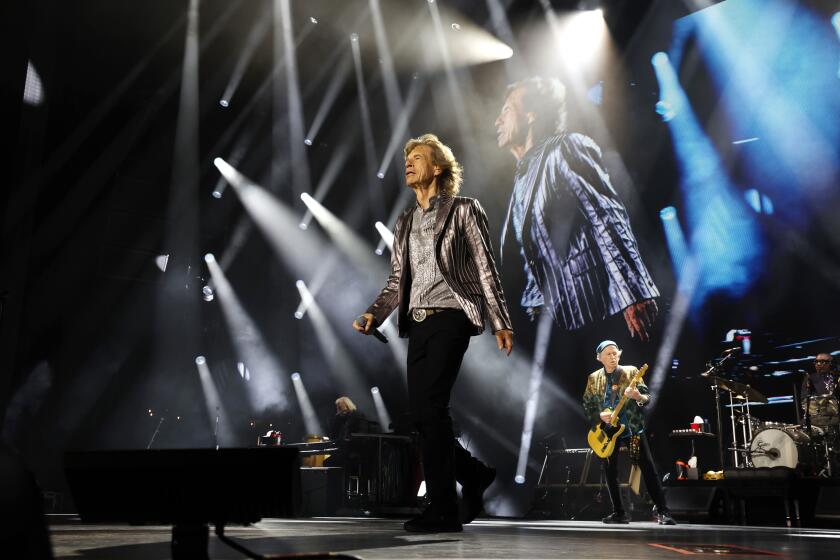Martin’s ‘Love’ fest
IMAGINE, for a moment, that you’re Maurice Koechlin or Emile Nouguier, the engineers Gustave Eiffel hired in the 1880s to assemble the magnificent Parisian tower he pictured in his mind rising to heights previously unachieved by mankind. Then imagine that almost four decades after you completed your job down to the last strut and rivet, four decades during which the world marveled at your construction genius, you’re invited to tear it down and turn the component parts into a bridge, a carousel and maybe a speedboat to boot.
Now you’ve got a sense of what longtime Beatles producer George Martin has done for “Love.”
That is the title of the Beatle-centric Cirque du Soleil show that’s been running in Las Vegas since June and the new Beatles album coming out Tuesday with music Martin and his son Giles assembled by slicing and dicing the Fab Four’s original recordings in ways often as breathtakingly innovative as the original creations.
In the parlance of 2006 pop music, it’s a collection of mash-ups, the first authorized by the Beatles’ notoriously protective and creatively conservative Apple Corps enterprise and the group’s label, EMI Records. It was just 2 1/2 years ago that EMI swooped down on then little-known DJ-mixer Danger Mouse and slapped him with a cease-and-desist order when he blended the quartet’s so-called “White Album” with rapper Jay-Z’s “Black Album” for his own “Grey Album,” which became a widely ripped and burned Internet sensation.
But for “Love,” the man often described as “the fifth Beatle” took scissors, scalpel and, in some instances, paper shredder to the original master tapes, giving even the most Beatle-savvy listeners a fresh spin on their ultra-familiar recordings.
“They did some pretty weird things originally,” Martin said recently while seated in the spot where he may be most at home when he’s not at his actual home in London: a recording studio, this one Capitol Records Studio A in Hollywood, where he and Giles spent two hours walking a visitor track by track through their radical revision of the Beatles oeuvre. “What we’re doing today is just an extension of that.”
The Martins spent the better part of four years working on this father-son project, dissecting some of the world’s most popular and beloved rock music, then stitching the shredded bits and pieces into entirely new sonic collages.
The album, which is being released in stereo on CD and in 5.1-channel surround sound on DVD, opens with a cappella vocals harmonizing on “Because.” Soon, the famous piano chord that explodes at the end of “A Day in the Life” swells up in reverse then is chopped off by the ringing chord that opens “A Hard Day’s Night,” which segues into guitar and drum solos from “The End.” Then the song gallops off into the famous London rooftop performance of “Get Back.”
George Harrison’s vocal from his mystical, Indian-inspired song “Within You Without You” gets a new rhythmic punch floating over the bass-and-drum track from the psychedelically minded “Tomorrow Never Knows.”
Ringo Starr sings the words to “Octopus’s Garden,” but the band is replaced by the string arrangement for “Good Night” from the “White Album” -- an arrangement composed and conducted by George Martin.
Still into the music
THE most endearing thing about Martin, now 80 and wearing two hearing aids, is to see just how much he’s still delighted, impressed and humbled by the musicians and the recordings he worked with half a lifetime ago.
A punchy mash-up that inserts part of Harrison’s “Taxman” guitar solo into “Drive My Car” over Starr’s jacked-up drum beat from “What You’re Doing” got Martin twisting in his swivel chair, his hands comfortably behind his head.
“In a lot of this, the drums are driving everything,” said Martin, whose patrician features, elegant silver hair and stately upper-class British accent -- to say nothing of that 1996 knighthood from Queen Elizabeth -- belie his roots as the son of a North London carpenter born shortly before the onset of the Depression. “After we’d gotten a lot of it done, I talked to Ringo and told him, ‘You know, what you did is really impressive.’ And he said ‘Yes, I know.’ ”
Later, while listening as the CD continues to roll through a melange of “Here Comes the Sun” and the rhythm tracks from “Within You Without You,” Martin breaks into an 80-year-old’s version of the robot dance.
It isn’t that no one else could have mashed up Beatles music (ask Danger Mouse). But Martin arguably is the only one whose reconfiguration of it matters, because he, more than even any individual Beatle, was fundamental to its birth. His understanding of it reaches virtually the molecular level.
That comes through in the “Love” version of “Strawberry Fields Forever,” which traces the song’s evolution from an early demo version with just John Lennon’s voice and acoustic guitar through various stages until it morphs seamlessly into the final full-blown arrangement.
Martin obviously has an abiding affection for the four musicians he often refers to simply as “the boys.” After first hearing them in 1962, he pronounced them “pretty awful,” yet he was one of the few British record executives who bothered to listen when manager Brian Epstein approached him for an audition. The group had been famously turned down by Decca and other labels, but Martin heard enough of a spark of originality that he offered the foursome a contract with the label he headed at the time, the EMI-owned Parlophone.
He was old enough to be a father figure -- he was 36, the Beatles ranged in age from 19 to 22 -- but they bonded at first because Martin had recorded some of their favorite comedians, among them Peter Sellers and Spike Milligan as well as the Beyond the Fringe and Goon Show comedy troupes. Martin went on to produce all of the Beatles’ studio albums except “Let It Be,” which was handled by Phil Spector.
It was Martin’s musical expertise that helped turn the sounds John, Paul, George and Ringo had in their heads into reality. It was his idea, and arrangement, for the string quartet accompaniment in “Eleanor Rigby.” It was Martin who concocted the apocalyptic orchestral buildup that gives “A Day in the Life” its cyclonic climax. All with technology virtually Jurassic compared with what he’s sitting in front of today.
“The way we made most of the records, especially in the early days,” Martin said, “was by playing the songs live in the studio, and they really could perform live.
“What we hoped to do [in “Love”] is to give the impression of hearing them live now,” he said, to which Giles added, “The idea was to strip away all the history and let people just hear them playing as a band. Listen to Paul’s vocal on ‘Eleanor Rigby’ ... you hear him really going for it.”
After just a few years and albums, the Beatles became prime advocates of the recording studio as a creative tool rather than simply a place to take audio snapshots of their live act. That became clear in the sonic sophistication of “Revolver” in 1966 and continued, with breathtaking growth, through “Sgt. Pepper’s Lonely Heart’s Club Band” the following year, “The Beatles” (a.k.a. “The White Album”) in ’68 and “Abbey Road” in ’69. In a sense, the real mash-up of “Love” is the Beatles’ experimentalist mind-set with the technological sophistication and musical lexicon of a new millennium.
One of the few disagreements between father and son, albeit a mild one, turned up in a Lennon mash-up of “Come Together,” “Dear Prudence” and “Cry Baby Cry,” during which George lightly grimaced and, almost under his breath, muttered, “There’s his major chord against my minor.”
Giles smiled, saying, “It always upsets him when we get to that one. He really hates that.”
Ignoring his father’s career advice early on, Giles, who was born the week “Abbey Road” went to No. 1 on the British charts, started his own career producing recordings by acts including Kula Shaker, Velvet Jones, the Alice Band and Hayley Westenra. His coming of age in the digital era is behind much of the technological magic worked on the Beatles recordings for “Love.”
Martin the elder and Martin the younger are both tall, lanky and strikingly handsome. In dress and manner their generational differences are apparent: George’s natty bronze sports coat and crisply pressed Oxford shirt, gray slacks and polished black dress shoes hail from an earlier, classier world than Giles’ casual long-sleeved shirt, blue jeans and white tennies.
One last collaboration
“LOVE” came about because of the friendship Harrison forged with Cirque founder Guy Laliberte nearly a decade ago. In the years leading up to his death in 2001, Harrison impressed on McCartney, Starr and Lennon’s widow, Yoko Ono, how much he wanted to see one final creative collaboration among what remained of the Beatles. Because it was essentially a dying wish, the others set aside differences that had long kept them at odds -- especially McCartney and Ono -- to bring “Love” to fruition.
Skeptics will point out that EMI overseas and Capitol here in the states know too well how profitable it is to release anything with the Beatles imprimatur on it, especially during the holidays. When the “1” hits collection was released in 2000, it went on to sell more than 10 million copies in the U.S. alone and introduced a whole new generation to Beatlemania.
The thought of medleys in the world of Beatles music raised the prospect of the worst kind of a Vegas-ized bowdlerization of one of the cornerstone catalogs in popular music. But even those poised to pounce on anything smacking of exploitation of the Beatles catalog have come away from “Love” impressed.
“There seems to be almost a complete lack of ‘cheese factor,’ ” former ICE Magazine editor and veteran Beatles watcher Pete Howard wrote after seeing it. “The whole presentation carries an air of dignity and class, with perhaps only the slightest touch of campiness.”
But Martin, too, recognizes what this project represents for him after so many years of the Beatles dominating not just his career, but his life.
At the finish of his hauntingly recast version of Harrison’s “While My Guitar Gently Weeps” -- an early demo version paired with Martin’s newly composed and recorded orchestral accompaniment -- Giles noted with pride: “I think it’s amazing that at age 80, he can still do something as edgy as that, and yet it still sounds like the Beatles.”
Matter-of-factly, George Martin said, “The first score I ever wrote for the Beatles was the one for ‘Yesterday,’ and there’s 40 years in between” that and the new “Guitar Gently Weeps” music.
With just the faintest trace of sadness, he said: “That’s the last score I’ll ever write for the Beatles.”
More to Read
The biggest entertainment stories
Get our big stories about Hollywood, film, television, music, arts, culture and more right in your inbox as soon as they publish.
You may occasionally receive promotional content from the Los Angeles Times.






